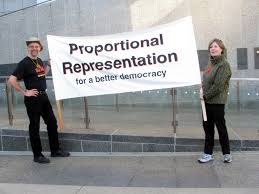Proportional Representation:

The ruling NDA has won 293 seats with a 43.3% vote share while the Opposition bloc INDIA has secured 234 seats with a 41.6% vote share. Other regional parties and independents polled around 15% but ended up with only 16 seats in total.
- The Proportional Representation (PR) system ensures representation of all parties based on their vote share.
- The most commonly used PR system is the ‘party list PR’ where voters vote for the party (and not individual candidates) and then the parties get seats in proportion to their vote share.
- India currently uses the First Past the Post (FPTP) system, where the candidate with the most votes in a constituency wins.
- The FPTP system is simple and provides stability to the executive, but it can lead to unrepresentative governments.
- To balance stability and proportionate representation, the Mixed Member Proportional Representation (MMPR) system can be considered.
- Under MMPR, there is one candidate elected through FPTP from each territorial constituency, and additional seats are allocated to parties proportionally based on their vote share.




